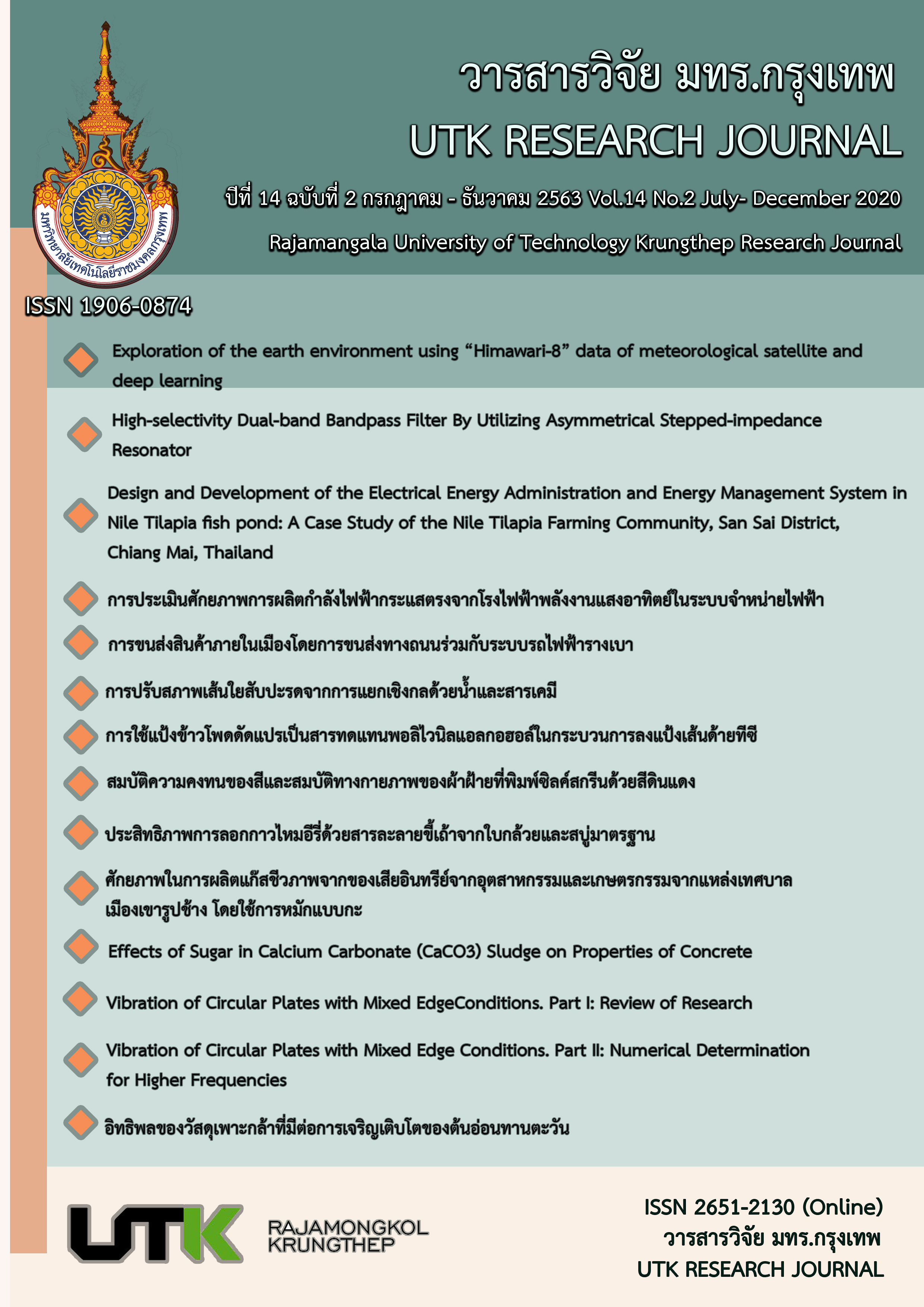Effects of sugar in calcium carbonate (CaCO3) sludge on properties of concrete
คำสำคัญ:
calcium carbonate sludge, slump, setting time, compressive strength, water cement ratioบทคัดย่อ
The sugar refining process typically produces waste, including calcium carbonate (CaCO3 ) sludge and wastewater. In this research, Portland cement in concrete work was replaced by CaCO3 sludge in three different levels: 17 , 50 and 83 %, respectively. The experiments were conducted by determining concrete slump, concrete setting time and compressive strength of concrete using original CaCO3 sludge (CO) with 2,000 ppm sugar and CaCO3 sludge (CW) with no sugar.
The experimental results indicated that original CaCO3 sludge (CO) could slow down the setting time of concrete and this could be solved by the replacement by CaCO3 sludge (CW). The CaC sludge was able to extend setting time as well as reduce workability of concrete. For this reason, the water cement ratio (w/c) at equal slump was higher than usual, resulting in lower compressive strength. However, CaCO3 sludge has its benefits in terms of lower concrete cost, reducing CaCO3 sludge which was hard to be eliminated and reducing cost of additional retardant to slow down concrete setting time working under hot conditions.
เอกสารอ้างอิง
Neville A. Properties of Concret. 4th Edition. Longman House. Harlow; 1995.
Ashworth R. Some investigations into the use of sugar as an admixture to concrete. Proc. Ins. 1965; 31: 129 - 45.
Gadzama E, Ekele O J, Anametemfiok V E, et al. Effects of sugar factory wastewater as mixing water on the properties of normal strength concrete. International Journal of Science. 2015; 4: 813 - 25.
Arpana D, Acharya V, Keerthi G. Effect of Sugar on Setting - Time and Compressive Strength of Concrete. ICGCSC; 2017 17th - 18th March; Mangalore Institute of Technology & Engineering, Moodbidri. India: 2017.
Jumadurdiyev A, Hulusi O, Saglamb A, et al. The utilization of beet molasses as a retarding and water reducing admixture for concrete. Cement and Concrete Research. 2005; 35(5): 874 – 82.
Bloem D. Preliminary tests on the effect of sugar on strength of mortar. National Ready - mixed Concrete Association Publication. Washington DC; 1954.
Garci J, Jennings H. New insights into the effects of sugar on the hydration and microstructure of cement pastes. Cement and Concrete Research. 2002; 32(3): 393 – 9.
Mindess S, Young J, Darwin D. Concrete. 2nd edition. London: Pearson Education; 2002.
Negasi N, Gebremichael S, Mahmoud K M, et al. Investigation of setting time and compressive strength of ready-mixed concrete blended with returned fresh concret. Construction and Building Materials. 2019; 197:428-35.
American Society of Testing Materials. ASTM C33 - 18. Standard Specification for Concrete Aggregates. ASTM International. West Conshohocken, PA: 2018.
American Concrete Institute. ACI 211. 1 -91. Standard Practice for Selecting Proportions for Normal, Heavyweight and Mass Concrete. ACI Manual of Concrete Practice. Michigan.
American Society of Testing Materials. ASTM C143 – 20. Standard Test Method for Slump of Hydraulic Cement Concrete. ASTM International. West Conshohocken, PA; 2020.
American Society of Testing Materials. ASTM C39 - 20. Standard Test Method for Compressive Strength of Cylindrical Concrete Specimens. ASTM International, West Conshohocken, PA; 2020.
American Society of Testing Materials. ASTM C403 - 16. Standard Test Method for Time of Setting of Concrete Mixtures by Penetration Resistance. ASTM International. West Conshohocken, PA; 2016.
Gambhir M. Concrete technology. Tata McGraw – Hill; 2004.
Abrams D. Design of concrete mixtures. Vol. 1. Structural Materials Research Laboratory. Chicago. Lewis Institute; 1991.
ดาวน์โหลด
เผยแพร่แล้ว
รูปแบบการอ้างอิง
ฉบับ
ประเภทบทความ
สัญญาอนุญาต
กองบรรณาธิการวารสารวิชาการ มหาวิทยาลัยเทคโนโลยีราชมงคลกรุงเทพ มีความยินดีที่จะรับบทความจากอาจารย์ นักวิจัย นักวิชาการทั้งภายในและภายนอกมหาวิทยาลัย ในสาขาวิชาวิทยาศาสตร์และเทคโนโลยี ได้แก่ สาขาวิชาวิทยาศาสตร์ วิศวกรรมศาสตร์ และสาขาอื่นๆ ที่เกี่ยวข้อง รวมถึงสาขาต่างๆ ที่มีการบูรณาการข้ามศาสตร์ที่เกี่ยวข้องวิทยาศาสตร์และเทคโนโลยี ที่เขียนเป็นภาษาไทยหรือภาษาอังกฤษ ซึ่งผลงานวิชาการที่ส่งมาขอตีพิมพ์ต้องไม่เคยเผยแพร่ในสิ่งพิมพ์อื่นใดมาก่อน และต้องไม่อยู่ในระหว่างการพิจารณาของวารสารอื่น
การละเมิดลิขสิทธิ์ถือเป็นความรับผิดชอบของผู้ส่งบทความโดยตรง บทความที่ได้รับการตีพิมพ์ต้องผ่านการพิจารณากลั่นกรองคุณภาพจากผู้ทรงคุณวุฒิและได้รับความเห็นชอบจากกองบรรณาธิการ
ข้อความที่ปรากฏอยู่ในแต่ละบทความที่ตีพิมพ์ในวารสารวิชาการเล่มนี้ เป็นความคิดเห็นส่วนตัวของผู้เขียนแต่ละท่าน ไม่เกี่ยวข้องกับมหาวิทยาลัยเทคโนโลยีราชมงคลกรุงเทพแต่อย่างใด ความรับผิดชอบด้านเนื้อหาและการตรวจร่างบทความแต่ละบทความเป็นของผู้เขียนแต่ละท่าน หากมีความผิดพลาดใดๆ ผู้เขียนแต่ละท่านจะต้องรับผิดชอบบทความของตนเองแต่ผู้เดียว
กองบรรณาธิการขอสงวนสิทธิ์มิให้นำเนื้อหา หรือข้อคิดเห็นใดๆ ของบทความในวารสารวิชาการ มหาวิทยาลัยเทคโนโลยีราชมงคลกรุงเทพ ไปเผยแพร่ก่อนได้รับอนุญาตจากกองบรรณาธิการ อย่างเป็นลายลักษณ์อักษร ผลงานที่ได้รับการตีพิมพ์ถือเป็นลิขสิทธิ์ของวารสาร






